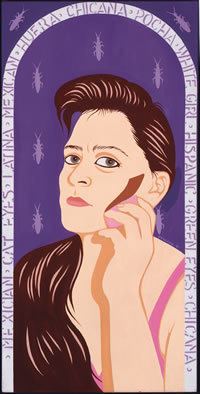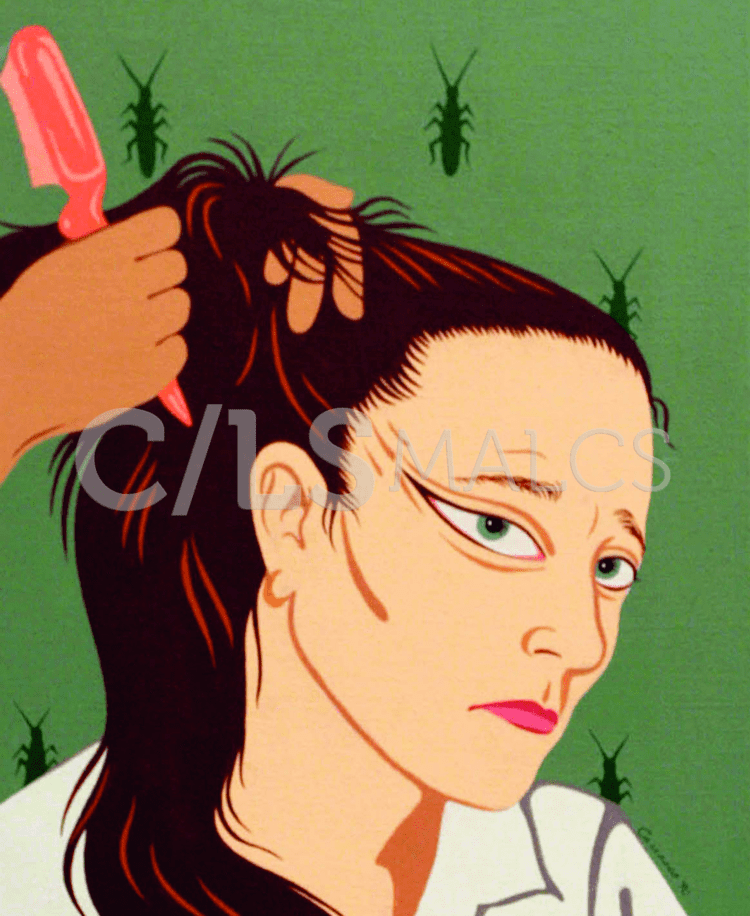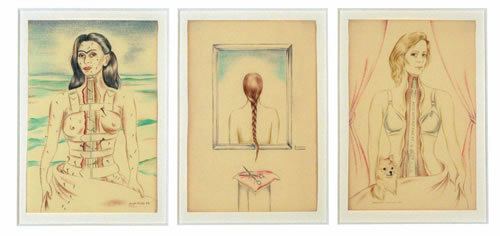Nationality American Movement Chicano Art Movement | Spouse(s) Harry Gamboa, Jr. Name Barbara Carrasco | |
 | ||
Education University of California, Los Angeles, California Institute of the Arts | ||
Barbara carrasco for congress
Barbara Carrasco (1955) is a Chicana artist and activist who lives and works in Los Angeles. She is considered to be a "renegade feminist" whose work critiques dominant cultural stereotypes involving socioeconomics, race, gender and sexuality. Carrasco is as equally comfortable as an artist in creating large-scale works, like murals, as she is with detailed, small-scale pen and ink work. Her art has been exhibited nationally and internationally. She was part of the important Chicano art exhibit, Chicano Art: Resistance and Affirmation (CARA). Carrasco continues to create art and teach others about art today.
Contents
- Barbara carrasco for congress
- Latin American Art Symposium Session 2 Barbara Carrasco and Esther Gabara
- Biography
- Art
- References

Latin American Art Symposium: Session 2, Barbara Carrasco and Esther Gabara
Biography

Carrasco was born in El Paso, Texas to Mexican-American parents. She was the second-oldest child and oldest girl in her family. She had two brothers and two sisters growing up. When she was around a year or so of age, her family moved to Los Angeles. They lived in government Veteran's housing in Culver City since her father was a Korean War Navy veteran. She recalls that they were poor and lived off of food stamps. Carrasco's childhood growing up in the predominantly Mexican-American and African-American community of Mar Vista Gardens was sometimes painful, because she was teased for having lighter skin than her peers and stood out for her green eyes; being called "white girl," "green eyes" and "güera." Her experiences with being simultaneously perceived as not truly Mexican-American and being told to "take advantage of being light skinned" makes up of part of her artistic subject matter later on in life. Carrasco said that her father encouraged her to broaden her horizons, go to college and encouraged her artwork. He had appreciated art and he was considered artistic. Her father, who worked as a bus driver for Santa Monica Bus Lines said that "anybody could be a bus driver but not everybody could be an artist." Carrasco's father died of a heart attack when she was twelve and it was difficult for her because she was always close to her father. Carrasco's mother, who also volunteered as a Girl Scout leader, was also artistically inclined. Her mother admired Japanese art and decorated the house with it. Carrasco felt that growing up with Japanese images influenced her sense of line. She also felt that her mother was a personal role model because she was a strong woman. Her mother was also, however, very protective of her girls, and she expected Carrasco to act as a role model of traditional femininity for her sisters.
Carrasco attended Catholic school from first to eighth grade. At school, like in her neighborhood, Carrasco felt that there was racism practiced there and that Anglo and white students were "treated better." She often drew on the tables at the Catholic school instead of paying attention to her lessons. Because she was so often in her own "little world of drawing," she repeated first grade. Some of the nuns, however, noticed and encouraged her talent, including Sister Mary Ann, who continued to stay in contact with Carrasco after she left school. In seventh grade, when she made her confirmation as a Catholic, Carrasco chose Saint Joan of Arc as her confirmation name because she was inspired by her leadership.
During the summers, she and her sisters were part of a program that helped young people from the projects attend classes at the University of California, Los Angeles (UCLA). Carrasco credits the program with also expanding her horizons and encouraging her to apply for college.
Carrasco attended Venice High School. Her high school art teacher, Mr. Shakagi, challenged her to try different mediums, including ballpoint pen, for creating art. Carrasco was very involved in both journalism and art in high school, but at the time hadn't started becoming very politically active yet.
Carrasco received her BFA in art from UCLA in 1978. She was the first person in her family to graduate from college. At UCLA, she was the first woman editor of the campus Chicano newspaper, the La Gente. Carrasco deliberately chose demanding art professors, like Jan Stussey, at UCLA who gave her a solid background in drawing. Carrasco was one of the first artists to join with Cesar Chavez's United Farm Workers (UFW) movement. She heard him speak at UCLA when she was nineteen and she says that she "volunteered right after the speech." She did volunteer artwork for Chavez for fifteen years because she believed both in his movement and in Chavez himself. Occasionally, Chavez was able to reimburse her for art supplies, but most of the work Carrasco did was unpaid. Carrasco helped create "monumental banners" for the United Farm Workers movement and protests. Right after graduating from UCLA, Carrasco helped work on art for the Zoot Suit play, which later opened on Broadway. She also became involved with the Public Art Center (Centro del Arte Publico) after UCLA. She was one of a number of women invited to join the Centro.
In the mid-1980s, Carrasco was commissioned to do a mural, The History of Los Angeles: A Mexican Perspective which led to a great deal of controversy. The publicity generated from the controversy, however helped Carrasco in some ways: she was chosen to go with a group of artists to the Soviet Union in 1985 and paint a mural in the Children's Museum in Yerevan, Armenia. She went on a second trip to the Soviet Union the next year and also took Dolores Huerta's thirteen-year-old son, Ricky, with her. She also went to Nicaragua in 1986 with a UCLA program called the Chicano Delegation to Nicaragua. It was during the Nicaraguan Revolution and the experience affected Carrasco deeply, making her think about death in a different context.
Carrasco received her MFA in art from the California Institute of the Arts (CalArts) in 1991. After graduating from CalArts, she didn't feel inspired and stopped producing art for about two years. In addition, the death of Cesar Chavez in 1993 created a sense of deep depression in Carrasco: she felt that there were not enough Chicano leaders and that few people could take his place.
In the mid 1990s, Carrasco married artist, Harry Gamboa Jr. Gamboa and Carrasco had been good friends first for some time, and Carrasco liked him especially because he was "supportive of women artists." In 1994, she had a daughter, Barbie. In 1995, she was diagnosed with lymphoma and in 1996 had a bone marrow transplant to treat the disease. After the transplant, Carrasco felt that her hand was less steady for detailed work.
She is a founding member of the Dolores Huerta Foundation and serves as a Board Member.
Carrasco was a UC Regents Professor in 2002-2003.
She was recognized as a "community champion" in Los Angeles in 2014.
Art
Carrasco's art is often very focused on social commentary. She uses her art to advocate change in the treatment of women. She has been publicly acknowledged for her role in making the Chicano art movement aware of sexist attitudes. Her art also addresses problems that she sees with religious dogma as it relates to women. Carrasco uses her art to bring attention to issues that would otherwise remain invisible. She also helps celebrate influential women, like in her "iconic representation" of Dolores Huerta. Carrasco herself has stated that because she was so political, her art hasn't been taken as seriously. Carrasco credits older Chicana artists, like Santa Barraza, with creating a "positive impact" on her work. She also enjoyed working with other Chicana artists in her generation, like her friend Yreina Cervantez. Carrasco's work often uses "fine lines, sharp detail and a hard-edged graphic quality."
Carrasco was active with the United Farm Workers (UFW), creating banners for them between the years of 1976 and 1991. Carrasco worked closely with Chavez to create many banners for conventions, rallies and supermarket demonstrations. One of the largest banners she created for the UFW was about 30 feet by 30 feet on vinyl with Nasdar ink. Carrasco had about two weeks to complete the work and recruited a few people to help her finish it on time. The last banner she did for UFW was Cesar Chavez's funeral banner.
Because of her critical stance towards culture, Carrasco has had her work rejected or censored based on the theme. Carrasco was commissioned to create a mural for the Los Angeles Bicentennial but her History of Los Angeles: A Mexican Perspective was too edgy for the project. The History of Los Angeles (1981), a 16 by 80 foot mural, sponsored by the Community Redevelopment Agency (CRA) became a portable mural that was only fully displayed one time because too many government officials felt it was too critical of events in American history. There were fifty-one separate events depicted in the mural. Events depicted in this mural include the Japanese American internment, the whitewashing of Siqueiros's mural, America Tropical, and the Zoot Suit Riots. Carrasco worked with three different historians to ensure that her information was accurate and conducted oral interviews with "city elders." To create the mural, she had 17 young assistants, many of them gang members. There were several times that CRA attempted to censor the subject matter in the mural and even attempted to destroy the mural itself. Carrasco refused to censor her mural because she felt "that it would be compromising the integrity of--not only my integrity as an artist but the mural, the history of L.A." Later, there was a court battle over the copyright of the mural, which Carrasco won. Carrasco felt that the controversy over the mural was tiring, but it also helped generate publicity for her as an artist.
In response to the censorship of the History of Los Angeles: A Mexican Perspective, Carrasco created the seriograph, Self-Portrait (1985) at Self-Help Graphics. Self-Portrait depicts an artist dressed as a runner crossing a finish line. The runner, carrying a paintbrush looks over her shoulder in horror as a paint-roller whitewashes the mural grid behind her. The whitewashing of Siqueiros's controversial mural is referenced again on the brush itself.
In 1989, Carrasco created a computer animation, PESTICIDES!, which was shown in Times Square in New York. It was considered "controversial."
Names Can Hurt (1991), was the first piece that Carrasco did which contained text. It was acrylic on canvas and contains many of the names she was called as a child growing up in Culver City.
One of Carrasco's most iconic images is her print, Dolores (1999). The image depicts a bust of Dolores Huerta on a flat background with just her name. The image has a pop art sensibility to it. Carrasco states that she isolated her portrait in such a way to show that Huerta was "strong enough on her own."
